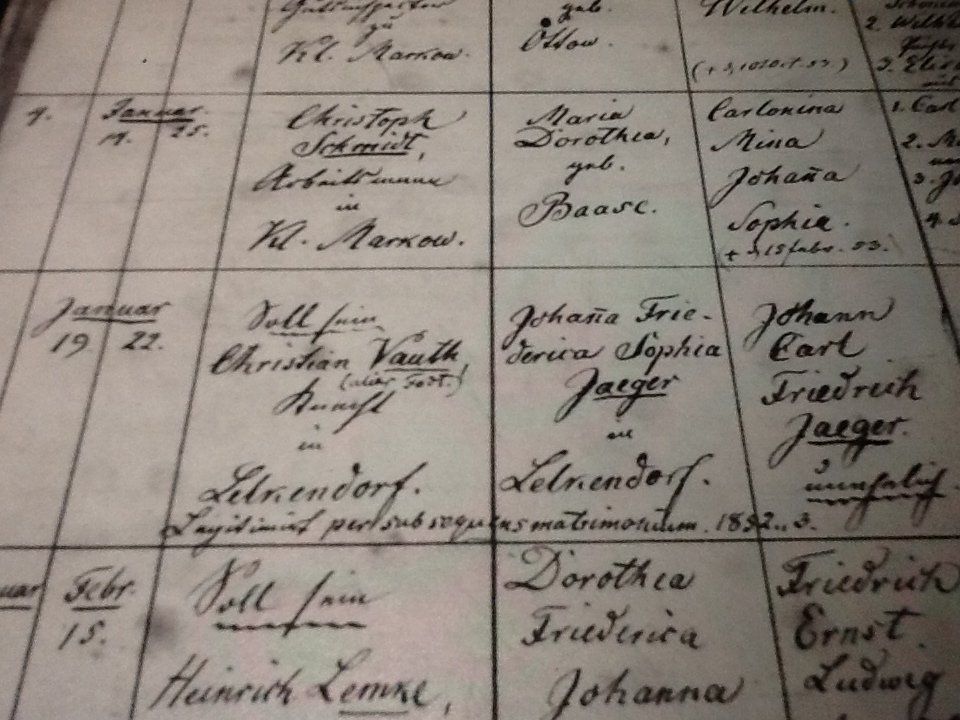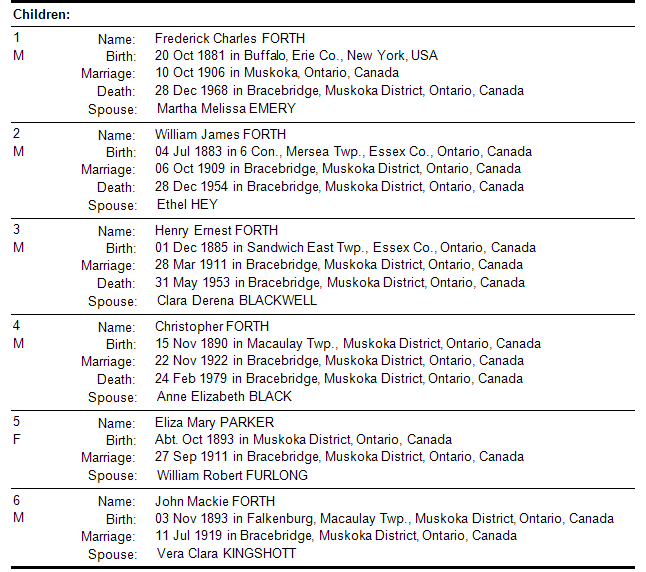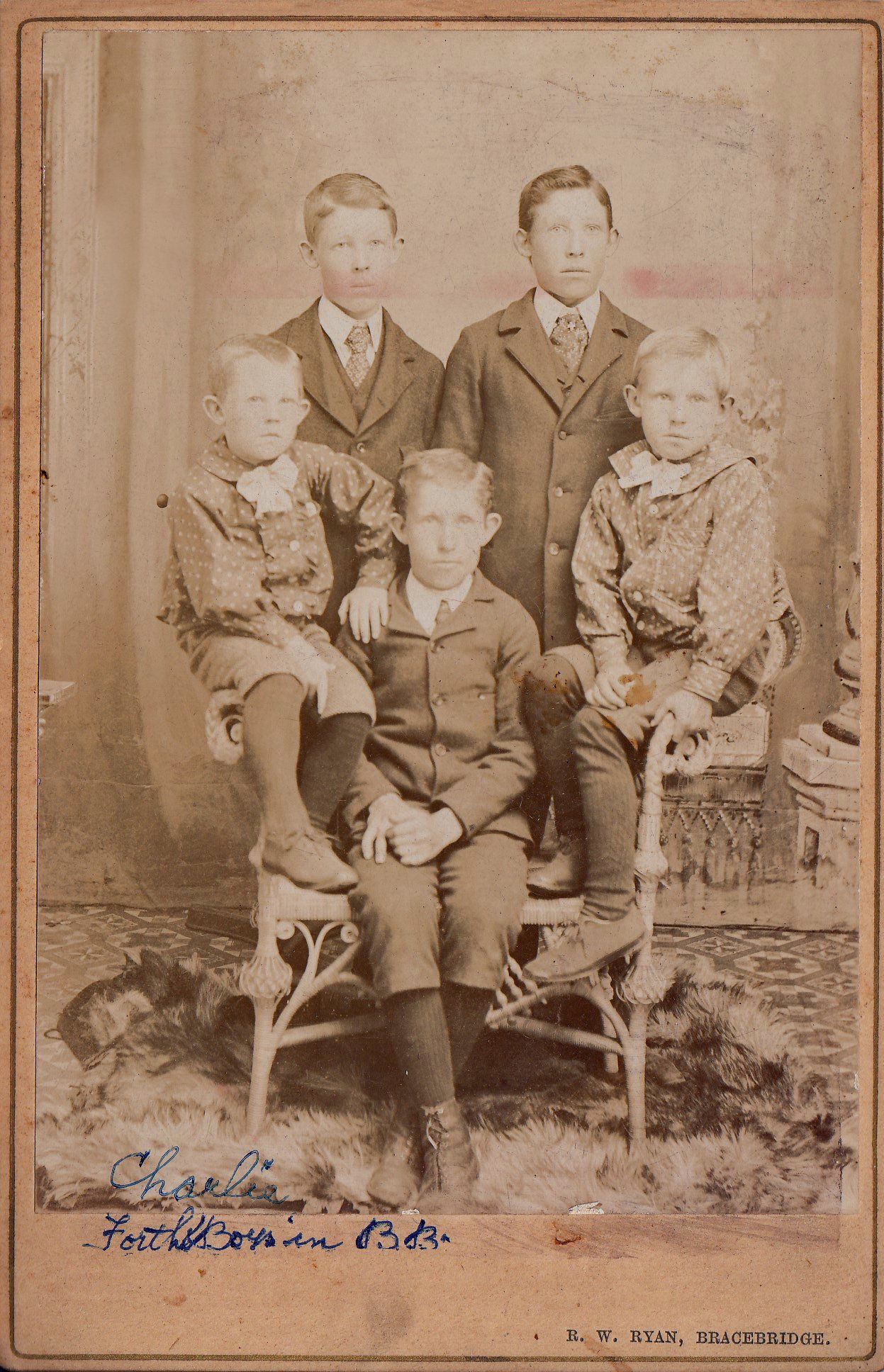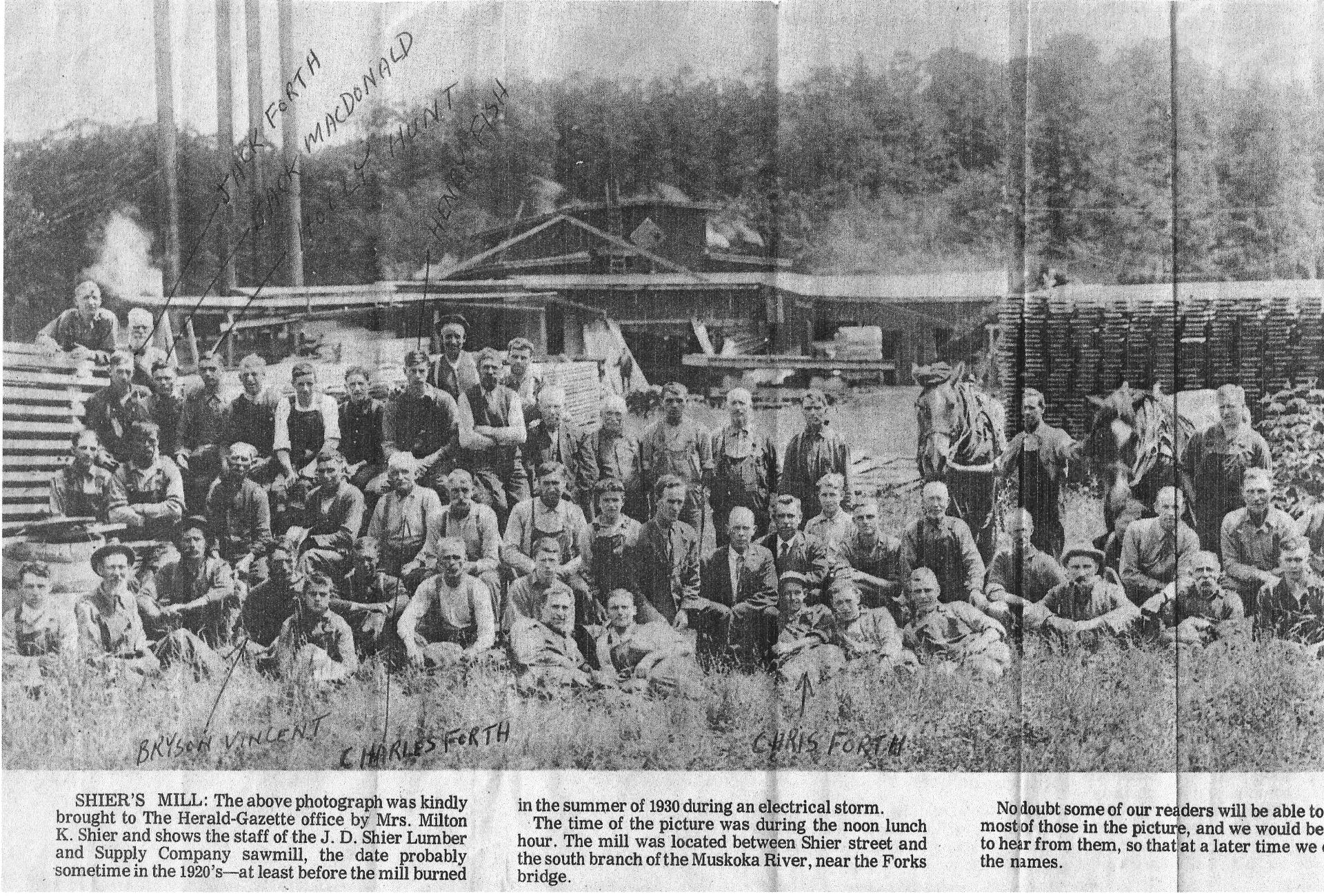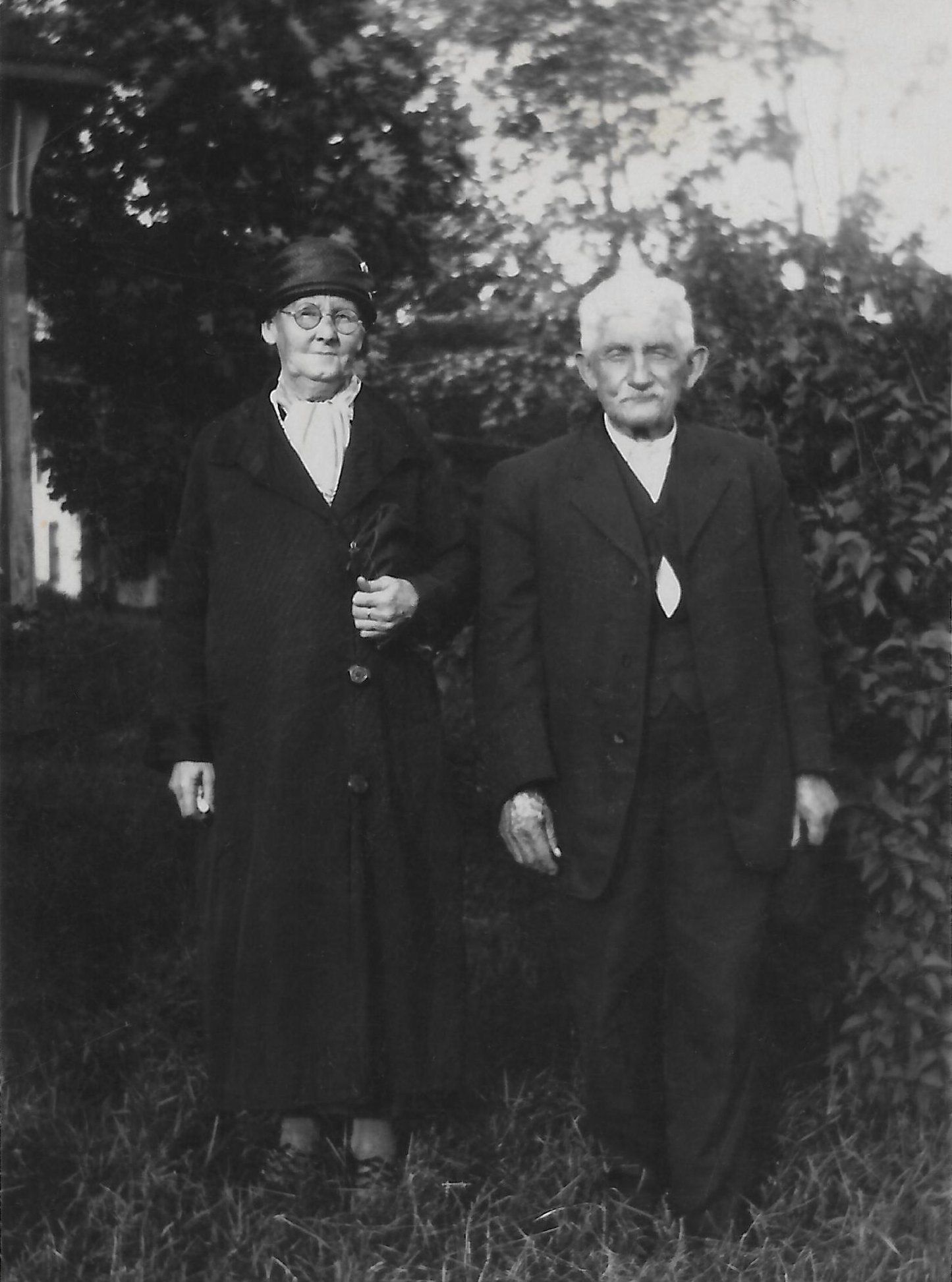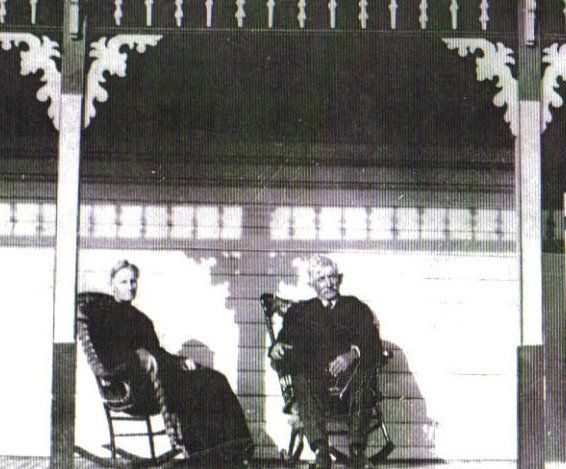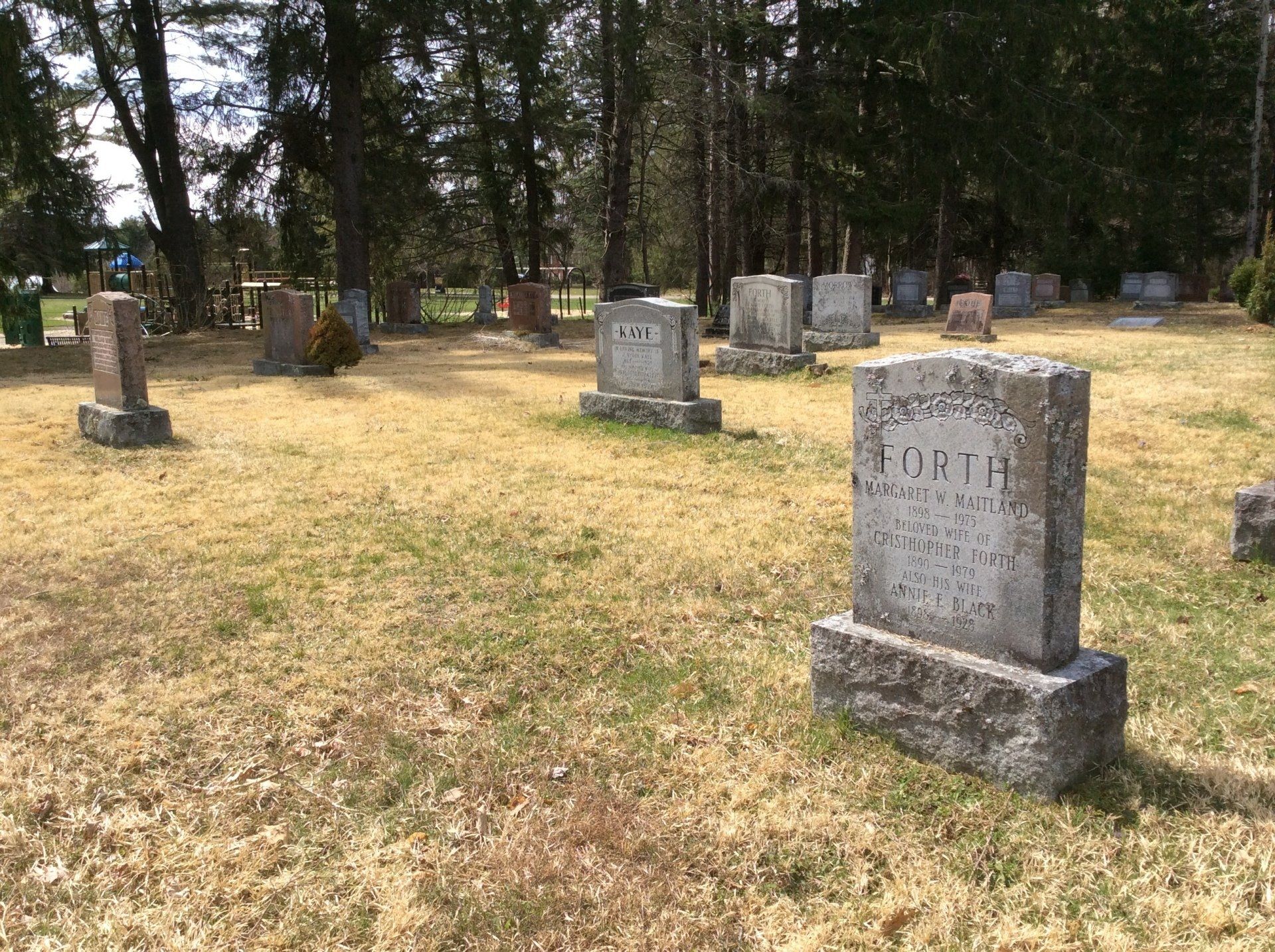Charles Frederick Forth
Charles Frederick Forth was born Johann Carl Friedrich Jaeger
on January 16, 1852 in Lelkendorf in the Grand Duchy of Mecklenburg-Schwerin. Carl was the eldest child of Christian Vauth
and Friederica Jaeger.
Christian and Friederica did not marry until October 22, 1852 at the parish church in Schorrentin. Carl, therefore, was born illegitimate. The word under his name is unehelich which means illegitimate in English. Also, over Christian’s name are the words Soll sein which translate to “presumably” or “should be” meaning the father was presumed to be Christian Vauth (alias Fodt). I noted that in the church records this was a standard notation by this pastor for illegitimate children. The Latin under both of their names is a notation written by the pastor to indicate that Christian and Friederica married later that year and that Carl was then legitimized.
Christian’s occupation was Knecht which can mean farmhand. Both Christian and Friederica were from Lelkendorf.
Carl was baptized January 22, 1852 and named for his godparents as was German tradition at the time.
His godparents were:
Johann Vauth, Knecht (farmhand),
Carolina
Jäger, Dienend (serving, likely in capacity as a maid or other household servant), and
Friedrich
Struck, Dienend (serving). All three were from Lelkendorf.
The surnames Vauth and Jäger suggest that the godparents were likely family members.
Carl emigrated with his family in October of 1864 and was recorded arriving at Castle Garden on lower Manhatten Island in New York in November of that year. He did not appear on the 1870 Census. The military record below is the first record I found for him after his arrival in New York state.
Carl enlisted in the U.S. Army on January 27, 1872 as Charles Forth. This is the first known record that uses the English form of Carl and also the surname Forth. Charles listed his place of birth as Buffalo and his occupation as teamster. He was recorded as 5’6” tall, with grey eyes, auburn hair and a ruddy complexion.
Charles was discharged on the January 27, 1877 at Fort McKavett, Texas, after the successful completion of five years of service as a private in B Company, 10th Regiment of the U.S. Infantry. His character was judged to be “excellent” and he re-enlisted immediately. On March 1, 1878, Charles was promoted to Corporal of B Company at Fort McKavett. The 10th Infantry was responsible for building roads and telegraph lines throughout Texas at this time.
I believe, B Company, 10th Infantry was sent to Fort Mackinac, Michigan in 1879 and from there to Fort Brady
in Sault Ste. Marie, Michigan. It was likely there that Charles met Camelia Isabella Graham, who may have moved there with her family from Kincardine, Bruce County, Ontario. Camelia, also known as Milly, was born November 17, 1857 in Kincardine. Her family was of Scottish origin and they had farmed in the Bruce Peninsula before moving to Sault Ste. Marie, Michigan sometime between 1871 and 1880. Camelia did not appear on the 1880 census for Sault Ste. Marie, but her parents and her sister Elizabeth did. It seems reasonable to assume that if Camelia had not moved there with her family, then she was visiting them when she met Charles Forth in Sault Ste. Marie.
Charles and Camelia were married April 7, 1881 in Sault Ste. Marie, Michigan. Camelia’s sister, Elizabeth, married a Daniel McIver the week before. The two couples were witnesses for each other’s weddings.
The Biographical Register of the Officers and Graduates of the U.S. Military Academy, by George W. Callum, lists an officer serving in the 10th Infantry at Fort Porter, New York in 1882. Fort Porter was located in Buffalo at the juncture of Lake Erie and the Niagara River. It served as a customs and guard house, but was abolished in 1925 when the Peace Bridge was built.
This places Charles Forth with the 10th Infantry in Buffalo at or just after the time his son, Frederick Charles Forth, was born on October 20, 1881. Charles was discharged as a Corporal on January 26, 1882 from Fort Brady at the expiration of his military service. Again, his character was listed as excellent.
Six months after his discharge, Charles enlisted on July 11, 1882 at Fort Porter, New York for a third tour in the U.S. Army. Fort Porter was located where the Peace Bridge is now. On the same enlistment record, Charles was listed as deserted on May 19, 1883. It is likely that he emigrated to Canada at that time as his second son, William James, was born on the 4th of July, 1883 in Essex Co., Ontario.
The April 6, 1891 Canada Census record for Charles Forth placed him and his family in Macaulay Township, Muskoka District, Ontario. Charles was a labourer and he and Camelia had four sons, Frederick Charles, William James, Henry Ernest and Christopher. Their son, John Mackie Forth, was born in 1893 and sometime before the Census of 1901, the Forths adopted a daughter, Mary Parker. On the 1911 Census, Parker was transcribed as Casker, but a marriage record that may well be for her indicates her surname was likely Parker. To me, it looks like Parker on the digital copy of the original.
Also on the 1911 Census for the Forth family, there was listed a William Furlong, age 19, boarder. On the 1921 Census, William Furlong was shown as married to Mary Furlong and their daughter was named Camellia. This leads me to believe that Mary Parker may have married William Furlong. There is a marriage record for William Robert Furlong and Eliza Mary Parker dated September 27, 1911. Interesting to note is that Christopher Forth, son of Charles, was one of the witnesses. The bride was given permission to marry with her guardians' consent so I think it is quite possible she was the person "adopted" by the Forths. Mary was 17 years and 11 months according to the marriage record, which would indicate a birth date of October, 1893, rather than the October 1896 date listed on the 1911 Census.
I believe the following is a correct listing for the five boys and adopted daughter of Charles and Camelia Forth. The photo is courtesy of Nancy White. It was likely taken in the late 1890's as youngest son, John, was born in 1893.
Census records in 1901 and 1911 indicated that Charles worked as a section man on the railway. I do not know whether he worked out of Utterson with his brother, Harry, or not. By 1921, he was working for the J. D. Shier Lumber and Supply Company at their sawmill in Bracebridge. Charles is labelled fifth from the left in the middle row of the photo below, and his son, Christopher, is in the first row, sixth from the right. Jack Forth, listed in the upper left, may well be Charles' youngest son, John Mackie Forth.
According to the 1935 Voter’s List, Charles was listed as a gentleman and was living at Alice Street in Bracebridge. The reference to gentleman simply means that Charles was retired and did not have to work for a living.
On July 30, 1937, Charles Frederick Forth died of broncho-pneumonia at Bracebridge Memorial Hospital.
Camelia died the following year, July 3, 1938 of degenerative myocarditis. Both were interred in the Bracebridge United Church Cemetery. There is no headstone to mark their place, but cemetery records show that they are buried in the plot beside their son, Christopher Forth.
Johann Carl Friedrich Fodt certainly made his mark in the New World. Although not up to the reproductive standards of his brother, Harry Forth, he was father to five sons and one adopted daughter, and grandfather to twenty-one or more grandchildren! He served in the U.S. Army for many years, owned a farm in Falkenburg, a lovely house in Bracebridge, and appears to have had a long and successful life.
Return to Henry Ernest Forth
